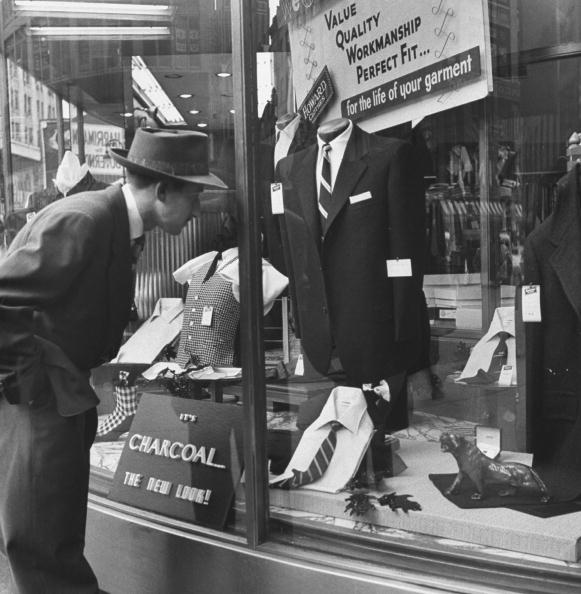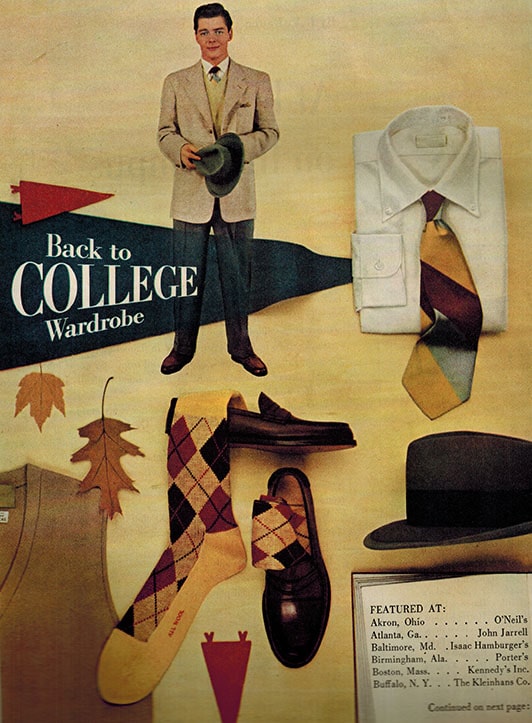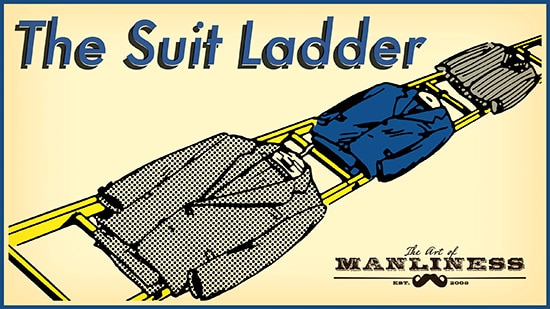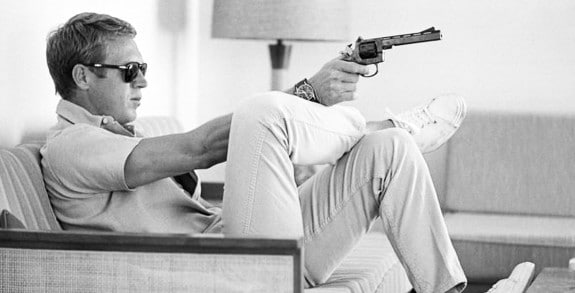
Any man can look fantastic with thousands of dollars in custom tailoring and wardrobe consulting. But can a man on a budget pull it off?
The simple answer is yes. Looking stylish is not reserved for people with six-figure salaries. You don’t have to buy this season’s latest from the top-name designers to look good.
But you do have to work a bit harder than someone who can just keep throwing money at the problem. Rich people get it easy — what else is new? Don’t worry too much about it. You can do great for pennies on the dollar if you’re willing to stick to the golden rules of affordable menswear shopping:
- Develop Reasonable Expectations
- Widen Your Shopping Options
- Invest in a Quality “Core” Wardrobe
It won’t come overnight and it won’t come effortlessly. But you can build a head-turning personal style from scratch without ever spending more than a few bucks on most items — as long as you’re smart about it.
1. Develop Reasonable Expectations
Shopping on a budget is about the long haul. You’ve got to be willing to hold out for the one-in-a-hundred good pieces that are worthwhile additions to your wardrobe.
That can be tough when you’re tired of your current options and looking to upgrade your style! But you’ll need to understand what you can — and can’t — have on a budget if you’re going to stay within costs.
Selection and Styles
We’ll discuss strategies for shopping on a budget in a minute, but here’s the reality of all of them: the selection isn’t as good as it is when money’s not an object.
That shouldn’t come as a huge surprise, and it isn’t a huge obstacle. You just have to accept that you’re not going to be able to constantly rotate through the latest hot trends when you’re also trying to save money. The latest thing always costs more than last year’s thing, even if it’s functionally identical.
So if you can’t expect to stay on top of the latest trends, what should your expectations for thrifty shopping be?
You should expect — and hold out for — decently-made clothes in good enough shape to last you several years. You should also expect clothes in a classic style that can be paired with pieces from many different styles, rather than a unified look. Bargain shopping is all about putting disparate pieces together into a sharp-looking whole.
Don’t count on finding something every time you go looking for clothes. In fact, plan on coming home empty-handed more often than not. But if you can hold back from purchasing anything but the best wardrobe additions, you can expect to eventually have a flexible, versatile wardrobe that can combine in dozens of different ways depending on your needs.
Fit and Adjustment
Affordable clothing, almost by definition, is not going to come tailored to your body. You’re mostly going to be relying on off-the-rack or second-hand items. The fit’s not going to be perfect.
Understand that, expect it, and plan on fixing it. After all, fit is at the top of the style pyramid for a reason. Buy only the clothes that can be adjusted to a personalized fit (or that fit so well they don’t need adjusting, and count yourself very lucky if you find anything that qualifies).
A few minor upgrades by a tailor can be a major upgrade for your wardrobe. If you buy clothes that can be taken in for a perfect fit, you’ll look much better than you would in pricier clothes that you left unaltered.
Be aware that there are some things a tailor can do easily and some things they can’t fix. Easy alterations include:
- minor shortening at the cuffs (jackets, pants, or shirts)
- very slight lengthening at the cuffs/hem (jackets and pants, but only if there’s extra material inside the sleeve/leg)
- shortening at the bottom hem (shorts and jackets)
- adding/removing cuffs (trousers)
- taking in a trouser waist for a skinnier fit
- fixing rips at seams or hemming a ragged edge
More challenging alterations that cost more money or just aren’t possible include:
- widening or tightening the collar (shirts)
- tapering the waist to be narrower (shirts and jackets)
- altering the width of the shoulders
- lengthening a shirt sleeve
- patching holes in the middle of the fabric
Look for the clothes that can be easily adjusted to your body (and that you like) — those are the ones that will give you the best value. You can’t expect to find something in both a style that you like and a size that’s workably close to your own, so be patient in your shopping and reasonable in your expectations, and don’t lower your standards on fit just because you like an item’s look (or vice versa).
Understanding the “Build Your Own” Look
One of the reasons expensive stores charge what they do is that they’re not just selling individual pieces of clothing. They’re selling a “look” that a designer put together for consumers.
That means that the top stores have everything planned out — not just what sort of suits they’re going to offer, but what shirts they’re going to display with them, what necktie colors and patterns they’re emphasizing that season, and so on.
A wardrobe built piece by piece over time from bargains and thrift stores isn’t going to have that kind of unified style. You’re not going to have a single “look” that comes ready to go straight out of the box.
And there’s nothing wrong with that. Most of the really stylish men in the world put their look together from different pieces. That’s how you get to look unique.
But you need to understand from the get-go that you’re shopping for a mix-and-match sort of wardrobe. Versatility is the most prized characteristic a piece of clothing can have. The more things you can wear it with, the more value you’re getting out of your purchase.
So shop with some strict expectations for interchangeability. The best-looking shirt in the world doesn’t do your wardrobe much good if you can only wear it with one of your pairs of trousers and none of your jackets. Skip it, and buy a more neutral shirt that’s less fun on its own but that can be worn with a wide variety of pants, jackets, and accessories instead.
2. Widen Your Shopping Options
Where are you doing most of your clothes shopping these days? Odds are you could expand your options, no matter what you answered.
There’s more than one place to find great bargains. Here are a few that you should keep your eye on as you build your affordable wardrobe:
Thrift Stores
Thrift stores, thrift stores, thrift stores. These are your best friends for value.
You can get some incredible bargains at thrift stores. Most of them have pretty hard maximum prices within their various categories — so, for example, a men’s wool suit with no obvious damage might automatically be priced at $25, regardless of whether it’s a Gap suit that originally cost $75 or a Brooks Brothers that cost $600.
The big disadvantage of thrift stores is, of course, the selection, which is why you need to approach them with reasonable expectations. Be ready to make a lot of trips that don’t turn up anything. Remember, you need to find something that’s both useful stylistically and in your size, or at least close enough that you can adjust it to your size.
You can often find the best pickings at thrift stores near the nicest neighborhoods and suburbs. Don’t just limit yourself to Goodwill — lots of private businesses run thrift stores, as well as various charities.
They’re hit or miss, but when they hit, thrift stores are often the best value out there. You can get full suits for a tenth of what they’d sell for in a department store, often ready to wear after $10 of adjustments.
Online Shopping
Shopping online as opposed to in brick-and-mortar stores usually gets praised for its convenience, but it can also save you some money — if you’re smart about it.
Most websites these days have online-only deals and prices, usually as short, limited-time offers designed to get you to spend money now as opposed to later.
A lot of them won’t be worth your while. But every once in a while one will, making it worth a bookmark on your favorite brands’ sites. Glance through their sales 2-3 times per week, ignore 95% of the offerings, and strike when you see the sale for something you really want. Also consider subscribing to Dappered and Primer, sites which alert readers to good deals and sales going on (in addition to providing general style tips and advice).
Be cautious, however, of the extra costs shopping online can bring. Getting a $45 sweater for $30 and then paying $15 in shipping and handling hasn’t actually saved you any money at all. You’ll want to keep an eye on the return policy as well — when you buy without trying on you often have to make exchanges, and if you’re on the hook for all the return shipping it can start to add quite a bit of cost.
The Sale Rack
Not everything has to be second-hand or an online purchase. Old fashioned shopping in retail stores can still turn up some real bargains. You just have to be sensible about it.
At most stores, with the exception of aggressive cost-cutters like the “big boxes” (Walmart, Target, etc.), full-price clothing isn’t going to qualify as “bargain shopping.” In fact, even clothes that are supposedly on “sale,” may not be a bargain either. Retail items these days come in and are immediately marked at a “sale” price, only seeing further reductions, and really being put on sale, if they aren’t moving.
In other words, something with a red tag (or whatever the “sale” color price tag is) may actually be selling for the original price the retailer planned to sell it as. They can call anything they like a “sale,” whether it’s cheap or not.
But true sales do happen, and real deals can be had, especially on anything that’s marked for “clearance.” Those are the items the store wants out the door and gone for good, usually last season’s wares or older. You can find some pretty good stuff in there for half its original price or less. Do know, however, that clearance items often aren’t returnable; when all sales are final, be extra sure you want what you buy.
“Big Box” and Other Cheap Stores
Generally speaking, you don’t want to be building your wardrobe at somewhere like Target or Walmart.
While their prices are great, the quality at the “big boxes” tends to be terrible. The clothes just don’t last that long. They also can’t help looking a little cheap — and, because each store has its own in-house brand with a uniform style, anyone who’s been to a Target or Walmart regularly will recognize the source when you wear that clothing.
That said, you can take advantage of the ultra-low prices the big box stores offer for a few things: socks and underwear are one obvious place, since they don’t get particularly close inspection and need regular replacement no matter how high-quality they are. And you can always find the occasional T-shirt or sweater that works really well with your personal style as well.
It’s probably worth picking up those sorts of items when you see them, especially if they’re on sale. Don’t plan on being a Walmart shopper for all your clothing needs, but if you shop there anyway you might as well keep an eye out.
Family and Friends
Hand-me-downs from father to son or older brother to younger are the most obvious family clothing swaps. It’s worth reaching out further than that, though. Put the word out that you’re looking to expand your closet, and wouldn’t mind taking old clothes off the hands of any relatives about your size. You may be surprised at what turns up from cousins, uncles, and even in-laws.
Don’t discount your older relatives either. Grandparents often have more stuff accumulated than anyone else in the family, and sometimes that stuff includes old suits or jackets that were put away with mothballs. Give them a good airing, get the necessary adjustments, and you’re good to go.
And anyone with some basic tailoring skills can help with repairs and adjustments, saving you some cash and a trip to the tailor when you need a seam stitched up or a button sewn back on to turn “shabby second-hand” into “stylishly vintage.”
Saying “No”
The most crucial skill to all these methods is passing things up.
It’s not hard to find deals. Sales are everywhere, some of them good and some of them not. But even the good sales won’t necessarily be on the items that benefit you personally.
Be picky. Refuse to compromise. Only buy clothing that looks sturdy enough to last a while, that suits your personal style, and that can be adjusted to fit your body without looking odd.
If it doesn’t meet all those qualifications, be willing to put even a real bargain back on the table. If you can avoid settling for less than the best, your wardrobe will be, well, the best.
3. Invest in a Quality “Core” Wardrobe
Does all this seem to suck the fun out of shopping? Don’t let it.
Bargain-hunting is all well and good to a point. If you’re really good at it (and have a little luck), you can build a boardroom-appropriate business outfit for $50.
But there are a few things worth a little extra investment in, and that’s the “core” items — the things that the rest of your wardrobe is based around.
These are different from man to man, but for most of us it means a couple pairs of trousers and jeans, a couple decent shirts, and a few jackets or sweaters, plus a suit for business occasions.
If you invest in real quality on those core items, it becomes much easier to add accent pieces to them for a good look.
The Timeless Styles
Your style is a matter of both personal taste and professional necessity. Every man’s is different. But there are a few looks that have always been good for men, and always will be, at a couple different levels of formality:
- Suits for business and formal occasions. The matched suit is the wellspring from which all modern menswear flows. It’s what you wear when you want to look your best, and you should have a good one for those occasions. Don’t know where to start? Use the suit ladder and gradually climb its rungs.
- Jackets for visual framing. While the number of situations where a man is required to wear a jacket is dwindling, a man still looks good in one almost everywhere. If your wardrobe includes a selection of jackets and blazers you’ll always be ready to throw something on over your shirt in a hurry and look “dressy” at a moment’s notice.
- Collared shirts. The turn-down collar is part of the core look. It’s not mandatory, and there are lots of occasions where you’ll want a T-shirt or some other option without a turndown collar. But you should always have a few plain old collared work shirts and dress shirts ready to go as part of the core.
- Leather shoes. These are a shortcut from “ordinary” to “snappy.” Blue jeans and an old work shirt suddenly become a style statement when you wear them with fancy leather shoes. Try to build a good wardrobe of these as part of your core.
Having those classic menswear elements ready to go puts you in a position where you can dress as conservatively and traditionally as needed on a moment’s notice — and where you can deliberately break the old rules of style to create your own effect just as easily.
When to Spend Big
There are a few occasions where you’ll want to bite the bullet and spend full price for a store item, rather than hunting through sale racks and thrift stores. There aren’t many of these occasions, but when they do crop up, don’t be shy about doing what you have to:
- Short notice. If you have a big presentation or interview next week and you don’t own a decent suit, you’re going to have to bite the bullet and go get one at whatever price is offered. Do it sooner rather than later — alterations can take a couple days, and every suit needs alterations, unless it was custom-made in the first place.
- Unique items. Every once in a while a designer will put out something that is absolutely perfect for your personal style. If it’s something that looks like it’s going to sell fast and isn’t likely to return, it’s probably worth buying at full price. Just save this judgment call for the most perfect and necessary of items — don’t use it as justification for anything but the very best.
- Long-term investments. Things that are going to last not just for years but for decades can represent a pretty big return on investment when you calculate their “cost per use.” Paying full price for a pair of $350 shoes might actually be worth it, if they’re going to be worn multiple times a week and come from a quality shoemaker whose products last for decades. Similarly, a $1,000 suit that lasts thirty years is a better buy than a $250 that wears out in five. Try to make all your big expenses ones with a long lifespan.
Summary: Looking Great for Less
Here’s a quick rundown on how to look like a million bucks for less than $50:
1. Develop Reasonable Expectations
- expect a limited selection of styles
- plan on coming home empty-handed more often than not
- know what alterations you can have done cheaply (and what you can’t)
- build your own look, rather than relying on a designer’s vision
2. Widen Your Shopping Options
- get to know the thrift store, and always look for new ones
- keep an eye on online deals from your favorite brands
- learn to navigate the sales rack — but beware of expensive “sales”
- consider cheap items from “big box” stores for minor pieces
- say “no” to almost everything, and only buy the perfect items
3. Invest in a Quality “Core” Wardrobe
- know what the timeless men’s styles are — and own them
- be willing to spend a little more on things that will last
- bite the bullet and pay full price if you’re in a hurry — but try not to often
If you can stick to these guidelines you’ll be avoiding all the shopping traps that skilled retailers have set for you. And pretty soon, you’ll look like a million bucks — for a lot less than that.
_________________________________________
Written By Antonio Centeno
Founder, Real Men Real Style
Click here to grab my free ebooks on men’s style







